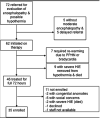Perinatal events and early magnetic resonance imaging in therapeutic hypothermia
- PMID: 20965514
- PMCID: PMC3035732
- DOI: 10.1016/j.jpeds.2010.09.003
Perinatal events and early magnetic resonance imaging in therapeutic hypothermia
Abstract
Objective: To compare the association between perinatal events and the pattern and extent of brain injury on early magnetic resonance imaging in newborn infants with and without therapeutic hypothermia for hypoxic-ischemic encephalopathy.
Study design: We performed a cohort study of 35 treated and 25 nontreated neonates who underwent magnetic resonance imaging. The injury patterns were defined a priori as: normal, watershed, or basal ganglia/thalamus-predominant, as well as a dichotomous outcome of moderate-to-severe versus mild-no injury.
Results: Neonates with hypothermia had less extensive watershed and basal ganglia/thalamus injuries and a greater proportion had normal imaging. Therapeutic hypothermia was associated with a decreased risk of both basal ganglia/thalamus injury (relative risk, 0.29; 95% CI, 0.10 to 0.81, P = .01) and moderate-severe injury. Neonates with sentinel events showed a decrease in basal ganglia/thalamus-predominant injury and an increase in normal imaging. All neonates with decreased fetal movements had injury, predominantly watershed, regardless of therapeutic hypothermia.
Conclusions: These results validate reports of reduced brain injury after therapeutic hypothermia and suggest that perinatal factors are important indicators of response to treatment.
Copyright © 2011 Mosby, Inc. All rights reserved.
Conflict of interest statement
The authors declare no conflicts of interest.
Figures
References
-
- Volpe J. Neurology of the Newborn. 5. Philadelphia: WB Saunders Comapny; 2008.
-
- Jacobs S, Hunt R, Tarnow-Mordi W, Inder T, Davis P. Cooling for newborns with hypoxic ischaemic encephalopathy. Cochrane Database Syst Rev. 2007:CD003311. - PubMed
-
- Azzopardi DV, Strohm B, Edwards AD, Dyet L, Halliday HL, Juszczak E, et al. Moderate hypothermia to treat perinatal asphyxial encephalopathy. N Engl J Med. 2009;361:1349–58. - PubMed
Publication types
MeSH terms
Grants and funding
LinkOut - more resources
Full Text Sources
Medical


